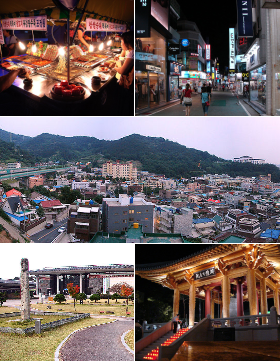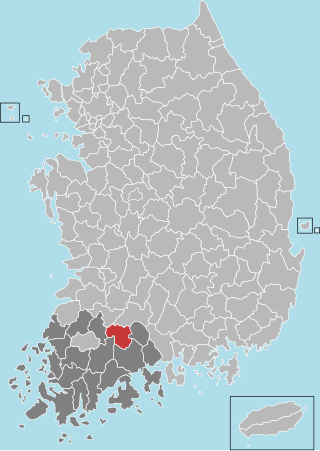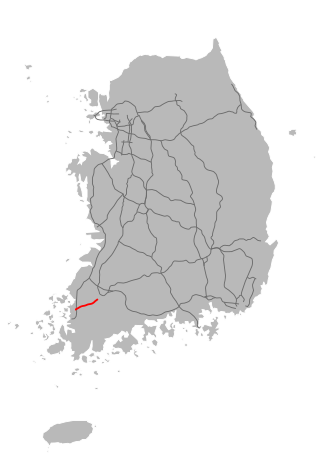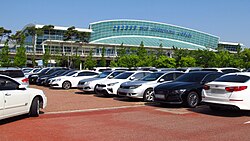
Jeonbuk State, also known as Jeonbuk is a Special Self-governing Province of South Korea in the Honam region in the southwest of the Korean Peninsula. Jeonbuk borders the provinces of South Chungcheong to the north, North Gyeongsang and South Gyeongsang to the east and South Jeolla to the south.

South Jeolla Province, also known as Jeonnam, is a province in the Honam region, South Korea, and the southernmost province in mainland Korea. South Jeolla borders the provinces of North Jeolla to the north, South Gyeongsang to the northeast, and Jeju to the southwest in the Korea Strait.

Gwangju is South Korea's sixth-largest metropolis. It is a designated metropolitan city under the direct control of the central government's Home Minister. The city was also the capital of South Jeolla Province until the provincial office moved to the southern village of Namak in Muan County in 2005 because Gwangju was promoted to a metropolitan city and was independent of South Jeolla province.

Mokpo is the third largest and most densely populated city in South Jeolla Province, South Korea, located at the southwestern tip of the Korean Peninsula, close to Yudal mountain. Mokpo has frequent high-speed train services to Seoul, and is the terminus for a number of ferry routes serving islands in the adjacent Yellow Sea and Dadohae National Maritime Park.
The Honam Expressway is an expressway serving the Honam region in South Korea. The freeway connects Nonsan on the Nonsan-Cheonan Expressway and Honam Expressway Branch Line to Gwangju and Suncheon on the Namhae Expressway. The freeway's route number is 25. The Honam Expressway Branch, (호남고속도로의지선) is route number 251, and connects Nonsan on the Honam Expressway to Daejeon on the Gyeongbu Expressway.
The Gwangju–Daegu Expressway(Korean: 광주대구 고속도로) formerly 88 Olympic Expressway(Korean: 88올림픽 고속도로, Pal-pal Oliympic Gosok Doro) is a freeway in South Korea, connecting Gwangju to Daegu (175.3 km). It was only expressway that has 2 lanes in South Korea.

Gokseong County is a county in Jeollanam-do, South Korea and the least densely populated subdivision of the province.

Buan County (Buan-gun) is a county in Jeonbuk Sate, South Korea. It is bounded by the city of Jeongeup on the east, the county of Gochang on the south, the city of Gimje on the north, and Yellow Sea on the west. Buan is divided into 1 eup, 12 myeon, and 510 ri. Buan had a 2001 estimated population of 74,716 people and a 2018 population of 54,441 people with an area of 493.35 km2. Famous people from Buan include Joseon Dynasty kisaeng and poet, Yi Mae-chang. Like many rural areas in southern Korea, it has seen shrinking population with many younger people moving north to larger cities such as Seoul. This county should not be confused with Muan, the new capital of South Jeolla Province.

Seocheon County is a county in Chungcheongnam-do, South Korea. It is famous for its seafood and location near the mouth of the Geum River.
Namak-ri is a small town in Samhyang-myeon, which is part of Muan County in South Jeolla province of South Korea. Namak-ri became the home of the South Jeolla provincial government following its move from the city of Gwangju in 2005.
Korea Cement Co, Ltd. is a South Korean cement and chemical company, headquartered in Sinan-dong Buk-gu Gwangju, Korea. established in 1962. It is a manufacturer of cement products, and is under the Gangdong Group family. The CEO of Korea Cement is Lee Kuk No (이국노).

Muan International Airport is an airport in Muan County, Jeollanam-do, South Korea. Construction of the airport began in 1997 and the airport opened on November 9, 2007. The airport serves the province of Jeollanam-do, especially the cities of Gwangju, Mokpo and Naju. It replaced the nearby Mokpo Airport and is expected to replace the nearby Gwangju Airport in the near future as well. In 2018, 543,247 passengers used the airport. The airport is managed by the Korea Airports Corporation.

The Honam high-speed railway, also known as Honam HSR, is a high-speed rail between Osong and Mokpo in South Korea. The line is a part of Korail's Korea Train Express (KTX) system, accelerating Seoul–Mokpo and Seoul–Gwangju KTX high-speed services which currently use the existing conventional Honam Line. On April 1, 2015, the line was inaugurated by the South Korean President Park Geun-hye with the attendance of 1200 invited guests and members of the public at Gwangju Songjeong Station in Gwangju, the line's terminus. The line diverges from Osong station on the Gyeongbu high-speed railway, and stops at Gongju, Iksan, Jeongeup Stations. Journey times between Seoul and Gwangju has been cut from 2 h 40 min to just 90 min, making daily commuting possible. The Honam HSR is intended to bring business, and economic opportunities to the province of Jeollanam-do, which has seen slower development than other parts of South Korea. The line has been open to the public since April 2, 2015 for revenue service.

The 2015 Summer Universiade was a Universiade held in the city of Gwangju, South Korea. It took place from July 3 to July 14, 2015.
Daebul Industrial Complex is an industrial complex which covers a large portion of Samho, Yeongam of South Jeolla province in South Korea. The complex was initially designed to set up fundamental base for development in the Mokpo area. Finalized in December 1996, the residence of enterprises start from 1997. The complex was initially aimed at the south east Asia and China market.
Hadang (Korean: 하당신도시) is the newly built urban area in Mokpo, Jeollanam-do of South Korea, which aims at accommodating increased population near Muan International Airport and movement of the provincial office. Before announcement of the transfer of office, Mokpo city initially intended to rebuild another area for housing. The project was finalized so until 1999 most of area was leased for marketing, business, housing, and preliminary purpose.

Changnyeong-eup is a town (eup) in the administrative county of Changnyeong, South Gyeongsang Province, in South Korea.

Slavery on Sinan County's salt farms relates to the discovery of human trafficking cases in Sinan County (신안군), Jeollanam-do (전라남도), South Korea in 2014. It was discovered that individuals, mostly the homeless, were kidnapped and sent to salt farms to work without any compensation.

Muan–Gwangju Expressway also known as 12th Expressway is an expressway in South Korea connecting Muan County to Gwangju.



















